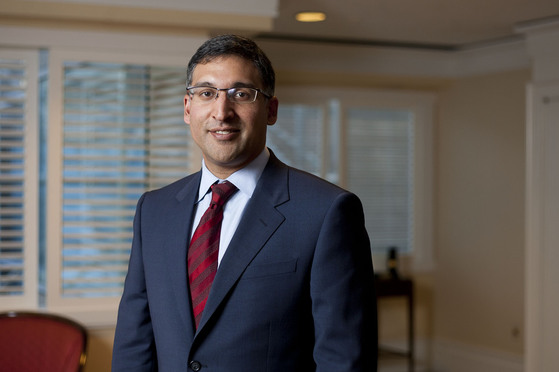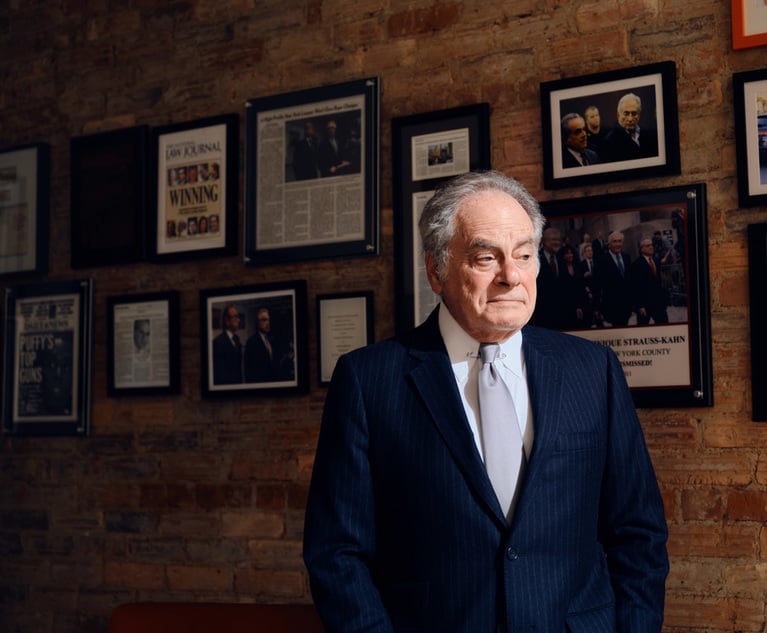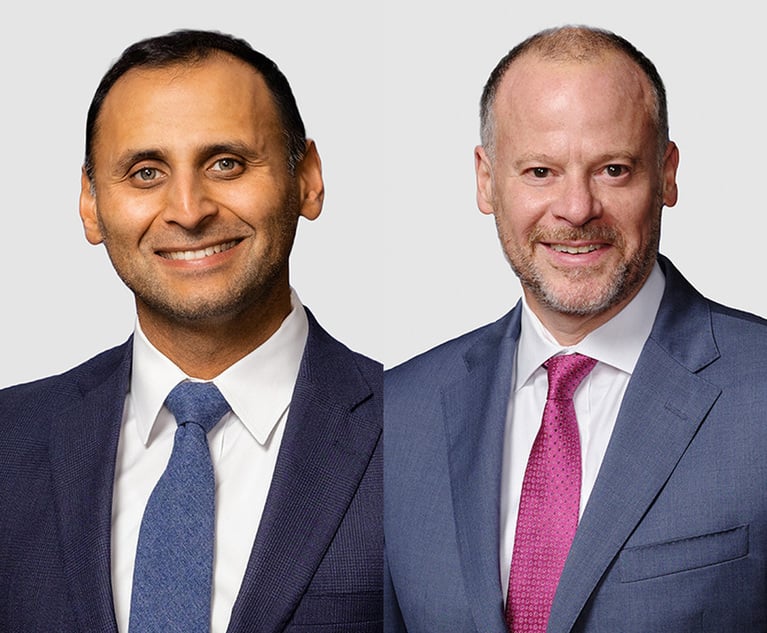For Neal Katyal, a Bittersweet Milestone
Bittersweet. That's how Hogan Lovells partner Neal Katyal describes breaking Thurgood Marshall's record, set in 1967, as the minority lawyer with the most oral arguments before the U.S. Supreme Court.
November 29, 2017 at 12:55 PM
5 minute read

Bittersweet.
That's how Hogan Lovells partner Neal Katyal on Tuesday described breaking Thurgood Marshall's record, set in 1967, as the minority lawyer with the most oral arguments before the U.S. Supreme Court.
Because why did the record stand for so long?
“It illustrates how far the bar still has to go,” he said in an interview. “Fifty years ago, we made some progress. But it's been stymied for a long time.”
Katyal's appearance on Tuesday in the securities case Cyan, Inc. v. Beaver County Employees Retirement Fund caps a remarkable year where he has argued seven cases in six separate arguments—more than any other advocate in 2017.
It brings his career total to 35 cases. He's on deck in January for his 36th, in Hall v. Hall.
His workload is almost mind-boggling. In addition to the oral argument on Tuesdayin the Cyan case, he had an emergency SCOTUS brief due the same day at noon. Oh, and a reply brief in support of certiorari for Google in a patent fight due Tuesdayas well.
Next week, he'll appear before the U.S. Court of Appeals for the Ninth Circuit challenging the travel ban in a televised argument.
Does he ever get a break?
“I'm going on vacation in…” he paused. “17 days.”
He's counting.
Disarmingly modest, Katyal is quick to credit his colleagues—“literally the dream team” —for making it all possible.
Among them: senior associates Mitchell Reich, Colleen Roh Sinzdak, Sara Solow and Thomas Schmidt.
“I firmly believe a lot of our associates are better lawyers than I am,” he said. And he's willing to share the podium. Roh Sinzdak co-argued against the travel ban in March, and Reich will have his chance next week, while Solow argued on behalf of Philadelphia in the sanctuary cities case earlier this month.
Meanwhile, Schmidt on Tuesday was in the Eastern District of Texas, handling oral arguments for Garmin in a major patent case, seeing as Katyal was otherwise engaged.
Katyal has a few high court pre-argument rituals. He always talks over the case with his children, who are now 16, 14 and 12. But the practice dates back 10 years (and suffice to say, if you can explain your case to a 6-year-old, you know how to simplify the issues).
He makes a special music mix to listen to when he drives downtown the day of the argument. On Tuesday, it included his favorite band, The National, as well as The Strokes, The Flaming Lips, The Shins, a few songs from “Hamilton,” and some Beethoven.
Like many advocates, he rubs the foot of the bronze statue of Chief Justice John Marshall on his way in to court.
And for every SCOTUS argument, Katyal wears a bracelet that belonged to his father, who was  half-Sikh and died 11 years ago. On Tuesday, he tweeted a photo of it alongside his brief in the Cyan case, with the caption 'This one's for you, Dad.”
half-Sikh and died 11 years ago. On Tuesday, he tweeted a photo of it alongside his brief in the Cyan case, with the caption 'This one's for you, Dad.”
His parents, Punjabi Indian immigrants, never wanted him to be a lawyer, Katyal said. As far as they were concerned, he should have been a doctor (like his mother) or possibly an engineer (like his father).
“They hated lawyers,” he said, adding that they actually cried when he announced he was going to law school.
Katyal traces his path to becoming a lawyer back to an uncle, who pointed out that he wasn't having much success as a member of the swim team. Perhaps he ought to try another activity, like debating?
“I was not particularly good right away,” Katyal said, but he realized that if he put in the work, he could succeed. He wound up competing in national tournaments, where he faced off against “arch rival” Tom Goldstein. Yes, that Tom Goldstein—the Goldstein & Russell name partner and co-founder of SCOTUSblog, who, it so happens, was opposing counsel in the Cyan case on Tuesday.
Debate made Katyal a good speaker, but he said it was professors at Yale Law School who took the time to teach him to write.
From there, he credits his “luck” in landing a job in the Clinton administration as special assistant to (then) Deputy Attorney General Eric Holder. And he sees luck again when President Obama picked Holder to be attorney general—which paved the way for Katyal to be hired as principal deputy solicitor general, then serve as acting solicitor general.
He joined Hogan in 2011.
“I'm the last person you would predict to be here,” he said of his success as lawyer. “I didn't go to fancy schools or come from money or from a family that valued law or public speaking in any shape or form.”
From his perch as the term's most sought-after Supreme Court advocate, and as one of the most prominent minority lawyers in the nation, Katyal sees value in continuing to call attention to the legal profession's lack of diversity, especially at the top.
Hiring and mentoring are priorities, and he makes small gestures too. For example, he won't appear on any of the myriad pre- and post-term Supreme Court discussion panels if the other speakers are all men.
Katyal said he is heartened that law schools have become more diverse, especially in terms of gender. His hope is that judges, when making career-altering decisions about who to hire as clerks, will do their part too.
“It becomes a big piece of how the legal profession and Supreme Court bar can improve,” he said. “But we have a long way to go.”
This content has been archived. It is available through our partners, LexisNexis® and Bloomberg Law.
To view this content, please continue to their sites.
Not a Lexis Subscriber?
Subscribe Now
Not a Bloomberg Law Subscriber?
Subscribe Now
NOT FOR REPRINT
© 2025 ALM Global, LLC, All Rights Reserved. Request academic re-use from www.copyright.com. All other uses, submit a request to [email protected]. For more information visit Asset & Logo Licensing.
You Might Like
View All
Amid the Tragedy of the L.A. Fires, a Lesson on the Value of Good Neighbors

Why the Founders of IP Boutique Fisch Sigler Are Stepping Away From the Law and Starting an AI Venture

Like a Life Raft: Ben Brafman Reflects on Nearly 50 Years as a Defense Attorney

Trying a Case for Abu Ghraib Detainees Two Decades After Abuse
Trending Stories
- 1New York-Based Skadden Team Joins White & Case Group in Mexico City for Citigroup Demerger
- 2No Two Wildfires Alike: Lawyers Take Different Legal Strategies in California
- 3Poop-Themed Dog Toy OK as Parody, but Still Tarnished Jack Daniel’s Brand, Court Says
- 4Meet the New President of NY's Association of Trial Court Jurists
- 5Lawyers' Phones Are Ringing: What Should Employers Do If ICE Raids Their Business?
Who Got The Work
J. Brugh Lower of Gibbons has entered an appearance for industrial equipment supplier Devco Corporation in a pending trademark infringement lawsuit. The suit, accusing the defendant of selling knock-off Graco products, was filed Dec. 18 in New Jersey District Court by Rivkin Radler on behalf of Graco Inc. and Graco Minnesota. The case, assigned to U.S. District Judge Zahid N. Quraishi, is 3:24-cv-11294, Graco Inc. et al v. Devco Corporation.
Who Got The Work
Rebecca Maller-Stein and Kent A. Yalowitz of Arnold & Porter Kaye Scholer have entered their appearances for Hanaco Venture Capital and its executives, Lior Prosor and David Frankel, in a pending securities lawsuit. The action, filed on Dec. 24 in New York Southern District Court by Zell, Aron & Co. on behalf of Goldeneye Advisors, accuses the defendants of negligently and fraudulently managing the plaintiff's $1 million investment. The case, assigned to U.S. District Judge Vernon S. Broderick, is 1:24-cv-09918, Goldeneye Advisors, LLC v. Hanaco Venture Capital, Ltd. et al.
Who Got The Work
Attorneys from A&O Shearman has stepped in as defense counsel for Toronto-Dominion Bank and other defendants in a pending securities class action. The suit, filed Dec. 11 in New York Southern District Court by Bleichmar Fonti & Auld, accuses the defendants of concealing the bank's 'pervasive' deficiencies in regards to its compliance with the Bank Secrecy Act and the quality of its anti-money laundering controls. The case, assigned to U.S. District Judge Arun Subramanian, is 1:24-cv-09445, Gonzalez v. The Toronto-Dominion Bank et al.
Who Got The Work
Crown Castle International, a Pennsylvania company providing shared communications infrastructure, has turned to Luke D. Wolf of Gordon Rees Scully Mansukhani to fend off a pending breach-of-contract lawsuit. The court action, filed Nov. 25 in Michigan Eastern District Court by Hooper Hathaway PC on behalf of The Town Residences LLC, accuses Crown Castle of failing to transfer approximately $30,000 in utility payments from T-Mobile in breach of a roof-top lease and assignment agreement. The case, assigned to U.S. District Judge Susan K. Declercq, is 2:24-cv-13131, The Town Residences LLC v. T-Mobile US, Inc. et al.
Who Got The Work
Wilfred P. Coronato and Daniel M. Schwartz of McCarter & English have stepped in as defense counsel to Electrolux Home Products Inc. in a pending product liability lawsuit. The court action, filed Nov. 26 in New York Eastern District Court by Poulos Lopiccolo PC and Nagel Rice LLP on behalf of David Stern, alleges that the defendant's refrigerators’ drawers and shelving repeatedly break and fall apart within months after purchase. The case, assigned to U.S. District Judge Joan M. Azrack, is 2:24-cv-08204, Stern v. Electrolux Home Products, Inc.
Featured Firms
Law Offices of Gary Martin Hays & Associates, P.C.
(470) 294-1674
Law Offices of Mark E. Salomone
(857) 444-6468
Smith & Hassler
(713) 739-1250






